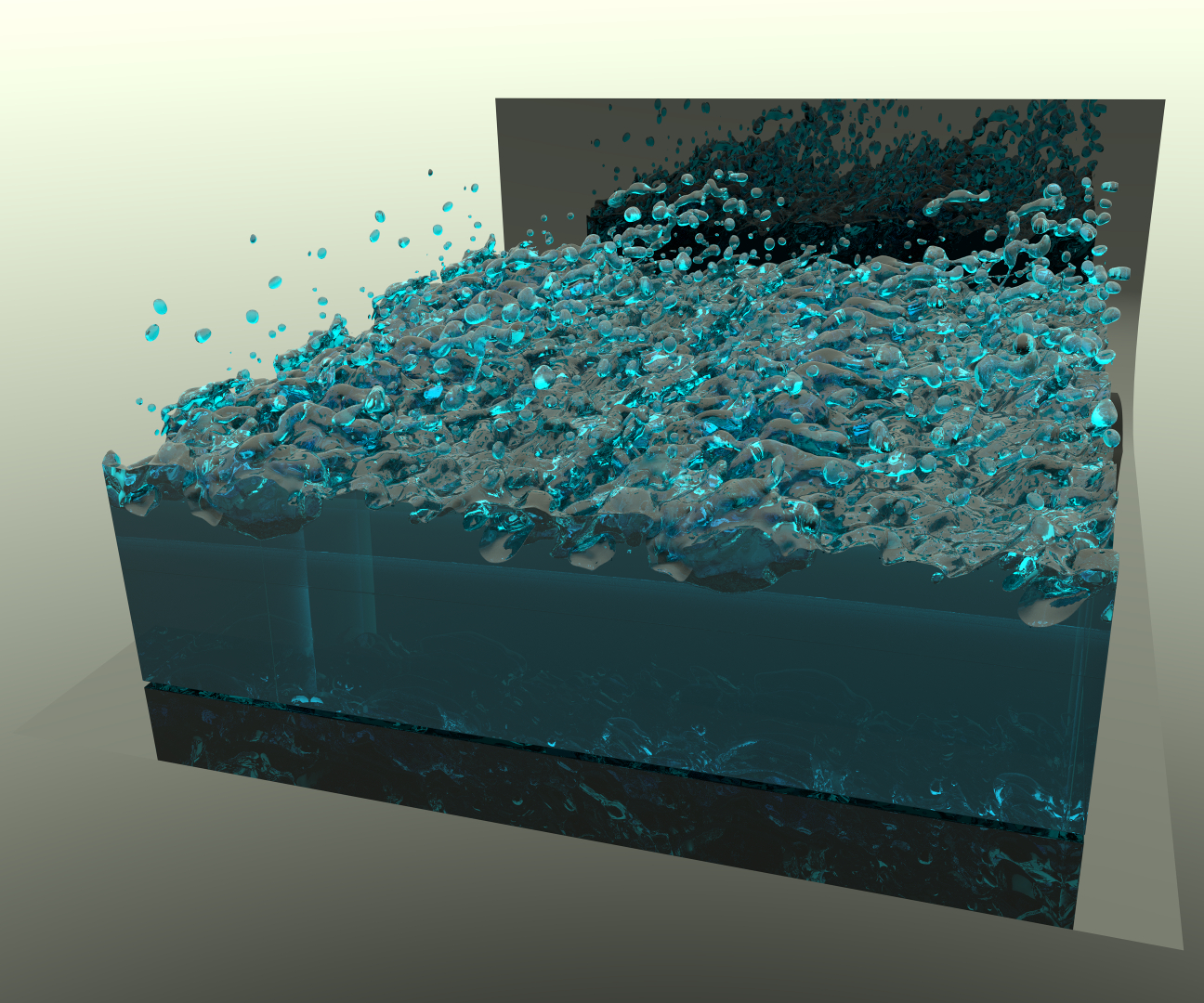Contact:
Fabien THIESSET, CNRS researcher
Context
Turbulent two-phase flows are multi-scale and multi-dimensional phenomena, i.e. which depends on:
– the region within the flow,
– the scales of the involved liquid structures
– the fluid/flow physical parameters.
When breaking-up, these liquid structures have complex
– geometry (surface area, curvatures),
– morphology (sphericity, ligamentarity)
– topology (connectedness)
– dynamics (singularity at finite time)
Motivation
Tackling the complexity and the multi-scale facets of liquid atomization requires elaborating a new theory:
– which draws explicit links with the geometry, morphology and topology of the liquid-gas interface,
– which allows scrutinizing the transport of liquid in both scale- and flow-position-space
– which allows some degree of predictibility and regularity to be recovered (in the statistical sense).

Realistic rendering of a liquid-gas shear flow simulated by the ARCHER code

Schematic representation of the phase indicator field ![]() . Gray zones represent the liquid phase (
. Gray zones represent the liquid phase (![]() ), white zones the gas phase (
), white zones the gas phase (![]() ). The two points
). The two points ![]() and
and ![]() together with the mid-point
together with the mid-point ![]() and the separation vector
and the separation vector ![]() are also sketched.
are also sketched.
Two-point statistical equations
We proposed using the machinery of two-point statistical equations which originates from the single-phase turbulence community which is adapted here to a relevant scalar in two-phase flows: the phase indicator function ![]() . This field variable is simply defined as:
. This field variable is simply defined as:
(1) ![]()
The transport equation for ![]() reads
reads
(2) ![]()
Writing Eq. (2) at two points ![]() and
and ![]() , arbitrarily separated by a distance
, arbitrarily separated by a distance ![]() , one obtains after some manipulations:
, one obtains after some manipulations:
(3) ![]()
In Eq. (3),
 is the increment (the difference) of
is the increment (the difference) of  between the two points,
between the two points, is called the second-order structure function of
is called the second-order structure function of  ,
, is the flux of
is the flux of  in scale space
in scale space  . It is generally referred to as the cascade process from one scale to the other.
. It is generally referred to as the cascade process from one scale to the other. is the flux of
is the flux of  in flow-position space
in flow-position space  , i.e. from one position in the flow to the other.
, i.e. from one position in the flow to the other.- The brackets denote average (to be specified)
Integral geometric measures
The litterature of porous media makes extensive usage of two-point statistics of the phase indicator. Some analytical results allows ![]() to be related to some geometrical properties of the liquid-gas interface. In particular, at small scales, the expansion of the second-order increments up to third order writes:
to be related to some geometrical properties of the liquid-gas interface. In particular, at small scales, the expansion of the second-order increments up to third order writes:
(4) ![]()
In Eq. (4)
 is the surface density of the liquid-gas interface
is the surface density of the liquid-gas interface is the area weighted averaged (squared) mean curvature
is the area weighted averaged (squared) mean curvature is the area weighted Gaussian curvature
is the area weighted Gaussian curvature is the angular average (over all orientations of the separation vector
is the angular average (over all orientations of the separation vector  )
)
Hence, the limit at small scales of Eq. (3) naturally degenerates to the transport equation for the surface density which reads
(5) ![]()
where ![]() is the stretch rate. At larger scales,
is the stretch rate. At larger scales, ![]() is expected to provide insights into the tortuousness of the interface.
is expected to provide insights into the tortuousness of the interface.
Simulation of the Plateau-Rayleigh instability using the ARCHER code. The surface is coloured by the local mean curvature ![]() .
.
(top) Simulation of homogeneous decaying liquid-gaz turbulence. (bottom) Simulation of liquid-gas shear flow. Both were carried out using the ARCHER code
Investigated flows
Homogeneous decaying liquid-gas turbulence
The framework has been first tested in homogeneous decaying liquid-gas turbulence. Homogeneity implies that the gradient w.r.t ![]() vanishes, thereby reducing the problem to the analysis of the scale/time evolution of the system (a 4D problem which depends on
vanishes, thereby reducing the problem to the analysis of the scale/time evolution of the system (a 4D problem which depends on ![]() and
and ![]() ).
).
Highlights:
– There exists a characteristic length-scale based on the surface density and liquid volume that allows characterizing the scale evolution of ![]()
– The stretch rate ![]() drives the cascade process of the liquid phase and hence plays the same role as the scalar dissipation rate for diffusive scalars.
drives the cascade process of the liquid phase and hence plays the same role as the scalar dissipation rate for diffusive scalars.
Results have been published in Journal of Fluid Mechanics:
Liquid-gas sheared turbulence
We then extended the analysis to a temporally evolving liquid-gas shear layer. In this situation, homogeneity holds only along two directions and one has to resort to the 5D version of the scale/space/time budget (3 dimensions for ![]() , 1 inhomogeneity direction, 1 dimension of time).
, 1 inhomogeneity direction, 1 dimension of time).
Highlights:
– The complexity of liquid transport in the combined space of scales and flow positions is exemplified.
– Some range of scales and flow positions comply with a direct transfer of ‘energy’ (from large to small scales), some others with an inverse cascade.
Results have been presented at the ILASS conference:





